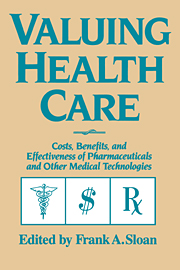 Valuing Health Care
Valuing Health Care Book contents
- Frontmatter
- Contents
- List of Tables
- List of Figures
- List of Boxes
- Acknowledgments
- 1 Introduction
- 2 Evidence of effectiveness: evaluating its quality
- 3 Utility assessment for estimating quality-adjusted life years
- 4 Measuring costs
- 5 From cost–effectiveness ratios to resource allocation: where to draw the line?
- 6 Valuing health care benefits in money terms
- 7 Discounting health effects for medical decisions
- 8 Statistical issues in cost–effectiveness analyses
- 9 Decision trees and Markov models in cost–effectiveness research
- 10 The use of cost–effectiveness/cost–benefit analysis in actual decision making: current status and prospects
- Notes
- References
- Index
2 - Evidence of effectiveness: evaluating its quality
Published online by Cambridge University Press: 07 December 2009
- Frontmatter
- Contents
- List of Tables
- List of Figures
- List of Boxes
- Acknowledgments
- 1 Introduction
- 2 Evidence of effectiveness: evaluating its quality
- 3 Utility assessment for estimating quality-adjusted life years
- 4 Measuring costs
- 5 From cost–effectiveness ratios to resource allocation: where to draw the line?
- 6 Valuing health care benefits in money terms
- 7 Discounting health effects for medical decisions
- 8 Statistical issues in cost–effectiveness analyses
- 9 Decision trees and Markov models in cost–effectiveness research
- 10 The use of cost–effectiveness/cost–benefit analysis in actual decision making: current status and prospects
- Notes
- References
- Index
Summary
The basic components of a cost–effectiveness analysis are demonstration of the relative effectiveness of the new technology compared to the old, conversion of the effectiveness of the new technology into a common unit of measurement of benefit in order to make this measurement comparable to that of other, competing technologies, and the measurement of the incremental costs. This chapter focuses on the quality of the evidence supporting the effectiveness of the new technology compared to older technologies; that is, the measurement of incremental effectiveness (Effect). Later chapters will review the principles of measuring costs and converting estimates of effectiveness into common units of measurement such as utility and benefit.
Nature of the evidence
Assessing relative effectiveness of a new technology
To understand the nature of the evidence supporting the effectiveness of new health care technologies, it is useful to review the types of health care technologies under consideration. A health care technology includes all interventions that require the use of both labor (e.g., clinicians) and nonlabor (e.g., pharmaceutical products or diagnostic equipment) resources. A wide variety of health care technologies is aimed at reducing the burden of disease, including pharmaceutical products, surgical techniques, diagnostic equipment, diagnosis and development and delivery of treatment plans, counseling services, and interdisciplinary programs involving combinations of all of the above. Measurements of effectiveness require demonstration that the new technology does more good than harm compared with the older technology when applied to a target group of patients and provided by a particular group of providers.
- Type
- Chapter
- Information
- Valuing Health CareCosts, Benefits, and Effectiveness of Pharmaceuticals and Other Medical Technologies, pp. 15 - 30Publisher: Cambridge University PressPrint publication year: 1995
- 3
- Cited by


